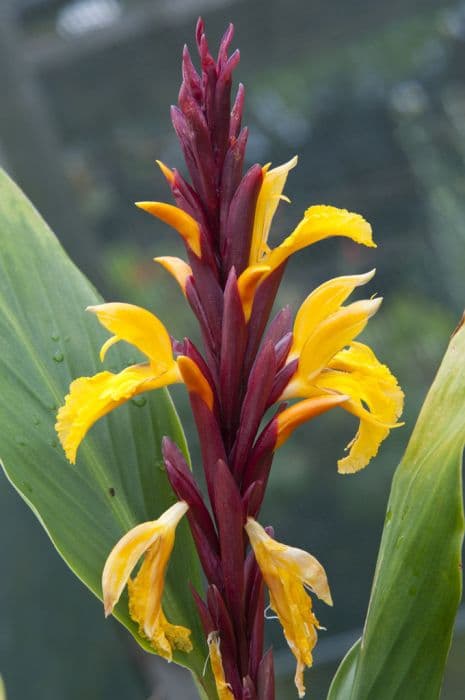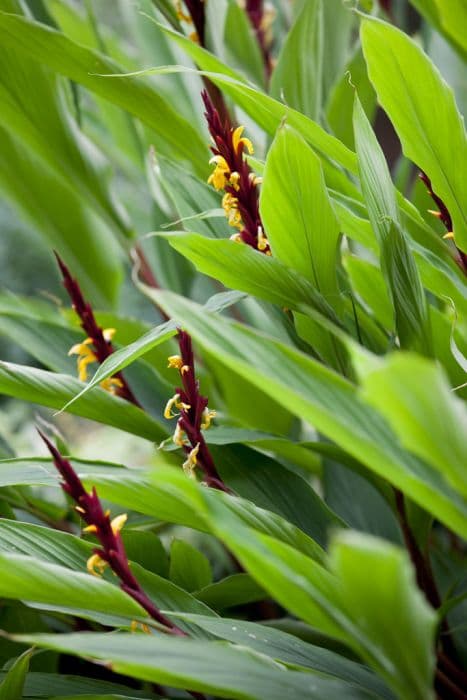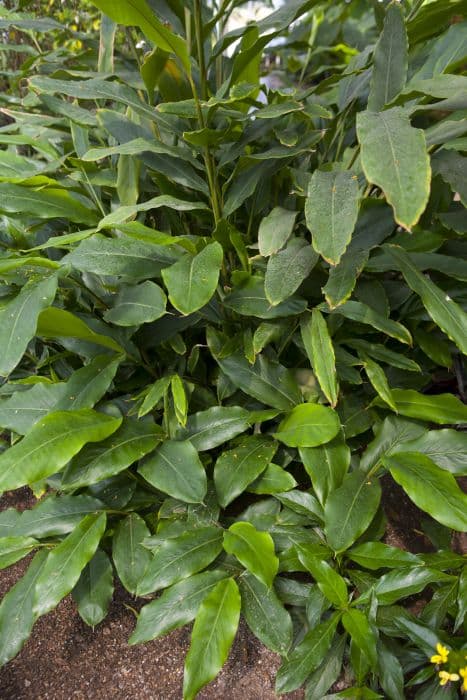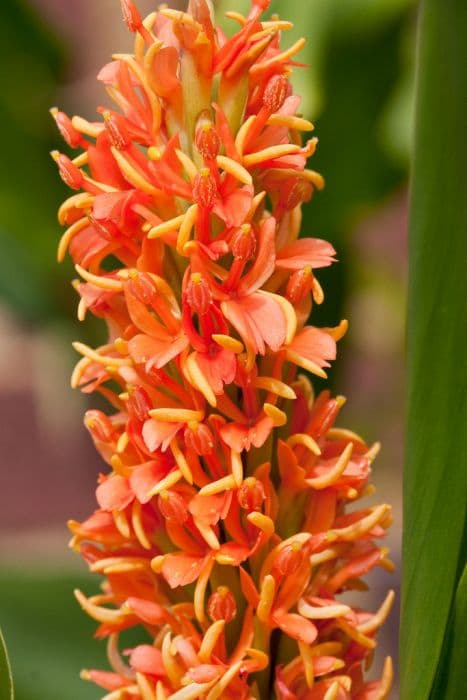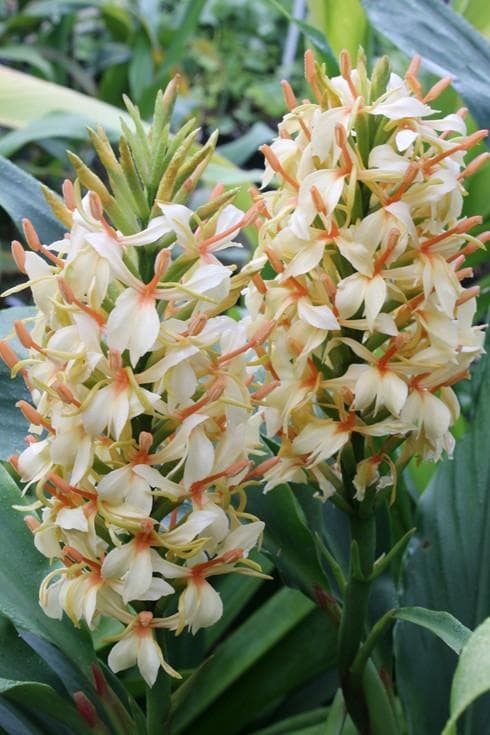Red ginger Lily Roscoea purpurea

ABOUT
Roscoea purpurea, commonly known as purple roscoea, is a perennial plant that boasts a lush clump of long, narrow, lance-shaped leaves, forming a striking tufted appearance. The foliage can vary in color from a deep green to a vibrant, lighter shade, providing a dense backdrop for the plant's most striking feature: its flowers. The flowers, which bloom in the summer, are exquisite and somewhat orchid-like. They exhibit a rich purple hue, though some may have a slightly paler lilac tone. Each flower consists of a series of petals that come together to create a tubular shape, which then flares out into a more open, delicate structure toward the end. The blossoms are typically arranged in a sequential order atop the tall stems that rise gracefully above the foliage. Additional charm is added by the lower lip of the flower, which is often marked with a contrasting shade of color, possessing a distinct, inviting look. The plant's overall aesthetic is one of exotic beauty, with the flowers providing an enticing display against the verdant leaves.
About this plant
 Names
NamesFamily
Zingiberaceae
Synonyms
Red Ginger, Roscoea, Crimson Roscoea
Common names
Roscoea angustifolia, Roscoea brandisii, Roscoea debilis, Roscoea purpurea var. angustifolia, Roscoea purpurea var. brandisii, Roscoea purpurea var. decipiens, Roscoea purpurea var. humilis, Roscoea purpurea var. longifolia.
 Toxicity
ToxicityTo humans
Roscoea purpurea, commonly known as Roscoea, is not widely recognized as a toxic plant to humans. There is limited information available regarding its toxicity, and it is not typically listed among plants that are poisonous to humans. Therefore, there are no well-documented symptoms or consequences associated with ingesting any part of this plant.
To pets
Similar to its effects on humans, Roscoea purpurea, or Roscoea, is not commonly known to be toxic to pets. There is little to no evidence suggesting that ingestion of this plant poses a significant health risk to animals. Consequently, there are no specific symptoms or known consequences of pets ingesting parts of the Roscoea plant. However, it is always wise to be cautious and keep an eye on pets if they have ingested any plant material, as individual reactions can vary.
 Characteristics
CharacteristicsLife cycle
Perennials
Foliage type
Deciduous
Color of leaves
Green
Flower color
Purple
Height
1-2 feet (30-60 cm)
Spread
1-2 feet (30-60 cm)
Plant type
Herb
Hardiness zones
6
Native area
Himalayas
Benefits
 General Benefits
General Benefits- Aesthetic appeal: Roscoea purpurea, commonly known as Himalayan ginger, produces attractive purple flowers which can enhance the visual appeal of gardens.
- Pollinator attraction: The flowers can attract bees and butterflies, aiding in pollination of garden plants.
- Easy to grow: Himalayan ginger is relatively low maintenance compared to other garden plants, requiring minimal care once established.
- Shade tolerance: The plant can thrive in partial shade, making it suitable for planting under trees or in shadowy parts of a garden.
- Resilience to pests: Himalayan ginger has a reduced susceptibility to common garden pests, reducing the need for pesticides.
- Durable: It is hardy in appropriate climate zones and can withstand cooler temperatures, returning each year as a perennial.
- Soil improvement: The plant can help in maintaining soil structure and health due to its perennial nature and root system.
 Medical Properties
Medical Properties- Antioxidant - Roscoea purpurea has been found to possess antioxidant properties, which can help in neutralizing harmful free radicals in the body.
- Anti-inflammatory - The plant has been traditionally used for its anti-inflammatory effects, which can help reduce inflammation and pain.
- Analgesic - It is used in traditional medicine for its pain-relieving properties.
- Antimicrobial - Roscoea purpurea is believed to have antimicrobial properties that can help fight certain bacterial and fungal infections.
- Immunomodulatory - Some research suggests that the plant may have effects on the immune system, potentially helping to modulate immune responses.
- Hepatoprotective - The extracts of the plant are thought to offer some level of protection to the liver, potentially guarding against certain liver diseases.
- Anti-diabetic - There is some evidence to suggest that Roscoea purpurea might be used in the management of diabetes by helping regulate blood sugar levels.
 Air-purifying Qualities
Air-purifying QualitiesThis plant is not specifically known for air purifying qualities.
 Other Uses
Other Uses- Roscoea purpurea, commonly known as the orchid ginger, is sometimes used as a food colorant due to its vividly colored flowers which can impart a gentle hue to dishes or beverages.
- The tuberous roots of orchid ginger have been traditionally used as a flavoring agent in some regional cuisines, contributing a subtle taste to various foods.
- This plant is cultivated as an ornamental, prized for its striking purple flowers which can add aesthetic value to gardens and landscaping projects.
- Orchid ginger's robust nature allows it to be used in plantings for erosion control, particularly in hilly or sloped garden areas.
- The foliage of orchid ginger can be used in floral arrangements, providing a tropical appearance and complementing other blooms with its rich green leaves.
- In regions where it is native, the durable fibers from the plant can be utilized in the crafting of small woven items like baskets or mats.
- The orchid ginger is also used as an educational tool in botanical studies, helping students learn about the characteristics of the Zingiberaceae family.
- Some cultures might employ the sturdy leaves of the orchid ginger in traditional food preparations, such as wrapping food before cooking or steaming.
- Photographers and artists may use orchid ginger as a subject to study natural forms, colors, and textures, both in its environment and as still life compositions.
- Orchid ginger can serve a role in companion planting, potentially deterring certain pests with its distinct scent and helping nearby plants thrive.
Interesting Facts
 Feng Shui
Feng ShuiThe Roscoea purpurea, commonly known as the purple roscos, is not used in Feng Shui practice.
 Zodiac Sign Compitability
Zodiac Sign CompitabilityThe purple roscos is not used in astrology practice.
 Plant Symbolism
Plant Symbolism- Rarity: Roscoea purpurea, commonly known as the Hardy Orchid, is not as commonly found as other garden plants, thus symbolizing uniqueness and rarity.
- Elegance: With its orchid-like flowers, the Hardy Orchid exudes elegance and beauty, often representing refined grace in a garden setting.
- Survival: As it can thrive in challenging climatic conditions where true orchids might not survive, it symbolizes resilience and adaptability.
- Charm: The delicate and charming appearance of the Hardy Orchid flowers represents enchantment and the subtle attraction in the language of plants.
- Mystique: Due to its exotic look and lesser-known status among general garden plants, it is associated with a sense of mystique and the exotic.
 Water
WaterFor Roscoea purpurea, commonly known as Hardy Ginger, it's essential to maintain a balance in moisture levels; the soil should be kept moist but never waterlogged. During the growing season, water the plant thoroughly once the top inch of soil begins to dry out, which typically happens once every week or two. Each watering session should provide water deeply enough to saturate the roots—using approximately half a gallon for a medium-sized pot is a good rule of thumb. Reduce the frequency of watering in the winter months when the plant is dormant.
 Light
LightHardy Ginger prefers bright, indirect light or partial shade. It thrives best when protected from the harsh afternoon sun, so a spot that receives morning sunlight with dappled shade in the afternoon is optimal. Indoors, placing it near a north-facing window or where it can get filtered sunlight through a sheer curtain would be ideal.
 Temperature
TemperatureHardy Ginger does well in temperatures between 50 and 75 degrees Fahrenheit. It can tolerate a minimum temperature of around 40 degrees Fahrenheit but should be protected from frost. The ideal temperature range promotes healthy growth and flowering.
 Pruning
PruningPruning Hardy Ginger is typically done to remove dead or damaged foliage and to maintain the plant's shape. It's best to prune in the spring before new growth starts. Pruning is usually not needed frequently, but an annual check to remove any unsightly or unhealthy leaves can help keep the plant vibrant.
 Cleaning
CleaningAs needed
 Soil
SoilThe Hardy Ginger Lily (Roscoea purpurea) thrives best in a moist, well-draining soil mix with high organic matter content. A mix of loam, leaf mold, or compost with added perlite or sand for drainage is ideal. The soil pH should be slightly acidic to neutral, ranging from 6.0 to 7.0 for optimal growth.
 Repotting
RepottingThe Hardy Ginger Lily should be repotted every 2-3 years or when it has outgrown its current pot. It is usually best to repot in the spring as the plant emerges from dormancy, allowing it to establish in the new container throughout the growing season.
 Humidity & Misting
Humidity & MistingHardy Ginger Lily prefers moderate to high humidity levels to thrive. A relative humidity around 60% is considered ideal for this plant. It benefits from a humid environment, but overly wet conditions should be avoided to prevent fungal issues.
 Suitable locations
Suitable locationsIndoor
Provide bright, indirect light and keep soil consistently moist.
Outdoor
Plant in partial shade, keep soil moist with good drainage.
Hardiness zone
6-9 USDA
 Life cycle
Life cycleRoscoea purpurea, commonly known as purple roscoca, begins its life cycle as a seed, usually germinating in spring when soil temperatures increase. The seedlings develop a rhizome, which is a horizontal stem underground that stores starches and proteins and gives rise to roots and shoots. From this rhizome, shoots emerge from the soil and grow into leafy stems, which bear lance-shaped leaves. Following leaf development, the plant produces distinctive purple flowers typically in the summer, which can attract pollinators like bees for sexual reproduction. After pollination, the flowers develop into capsules containing seeds. As autumn approaches, the above-ground parts of the plant die back, and the rhizome remains dormant underground during the winter, ready to regrow in the subsequent spring.
 Propogation
PropogationPropogation time
Spring to summer
Propogation: The most popular method for propagating Roscoea purpurea, commonly known as purple roscoea, is through division. This should ideally be done in the spring just as the new growth begins to emerge. Carefully unearth the clumps of the plant and gently separate them into smaller sections, ensuring that each has at least one growth point. These divisions should then be replanted promptly into well-draining soil at the same soil depth as they were originally growing. It's important to water the newly planted divisions thoroughly to help them establish in their new environment. Keeping the soil moist but not waterlogged will encourage the divisions to root and grow into healthy new plants.
